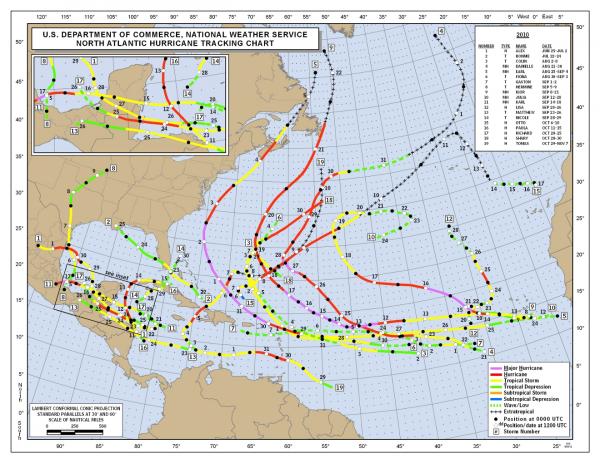
Warm Ocean Water Keeps Hurricanes at Bay, Study Finds

Hurricanes are more likely to miss the United States when there is a huge swath of warm water in the Atlantic Ocean, reveals a new study of recent hurricane trends.
So far, this year's hurricane season has been an active one, with 16 named storms (which include tropical storms and hurricanes), five hurricanes and two major hurricanes (those Category 3 or stronger on the Saffir-Simpson scale).
Last year's hurricane season was even more active. With 12 hurricanes in the Atlantic,the season was one of the most active ever. But unless you live in the Caribbean, you probably did not notice. None of last year's hurricanes made landfall in the United States. And only one, Hurricane Irene, which roared along the East Coast, has so far made landfall this year. [Infographic: Storm Season! How, When & Where Hurricanes Form]
What boosted the U.S.'s luck?
Warm pool expansion
The new study found that a huge swath of warm water kept the 2010 hurricanes at bay. Warm water in the Gulf of Mexico, the Caribbean Sea and the western tropical North Atlantic, the so-called Atlantic warm pool, shifted to the east in 2010. That shifted hurricane creation further east in the Atlantic, making it more likely that steering currents in the atmosphere would make the storms curve away from the United States coast as they roared west.
In 2010, the warm pool was "very, very large," said study team member Chunzai Wang, an oceanographer with the U.S. National Oceanic and Atmospheric Administration (NOAA). In 2010, the pool was more than double its normal size.
Sign up for the Live Science daily newsletter now
Get the world’s most fascinating discoveries delivered straight to your inbox.
The warm pool was so big that it blocked the effects of that year's La Niña. During La Niña years, cooler-than-average Pacific Ocean temperatures influence global weather patterns. La Niña years have been linked to active hurricane seasons.
"There's many factors that control the hurricane track," Wang told OurAmazingPlanet. "The Atlantic warm pool is only one of them. But In 2010, the warm pool played a major role."
About 25 percent of a season's hurricanes will typically hit the United States. That number falls by almost half in years with a swollen Atlantic warm pool, the new study found.
Like a leaf
The new finding may seem counterintuitive because warm ocean waters are what fuel big hurricanes, but the study doesn't contradict that bit of basic hurricane science. It's just that the warm waters not only feed a hurricane's fire, but they influence the atmosphere as well.
Wang said a hurricane behaves like a leaf floating in a river, totally at the whim of the current. So goes the river, so goes the leaf. A large Atlantic warm pool causes the atmospheric "river" to steer toward the northeast, carrying a hurricane with it.
"How the hurricanes go depends on the atmospheric steering flow pattern," Wang said.
The sample size for the study is small, since reliable hurricane records have only been kept since 1950 and more detailed satellite data only since 1970. Hurricanes are a complicated phenomenon, and there are many factors at play, Wang said, but at the very least, the study explains why no 2010 hurricanes hit the United States.
Just because a hurricane forms further to the east does not necessarily mean it has a strong chance of curving away from the East Coast, said atmospheric scientist Jeff Weber of the University Corporation for Atmospheric Research in Boulder, Colo. There are other atmospheric patterns in play, but they are not divorced from the Atlantic warm pool.
"I wouldsuggest that the [Atlantic warm pool] is a player in land falling East Coast hurricanes,but not the final word," Weber said.
- In Photos: Hurricane Irene's Fury
- History of Destruction: 8 Great Hurricanes
- Natural Disasters: Top 10 U.S. Threats
You can follow OurAmazingPlanet staff writer Brett Israel on Twitter: @btisrael. Follow OurAmazingPlanet for the latest in Earth science and exploration news on Twitter @OAPlanet and on Facebook.









